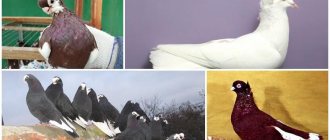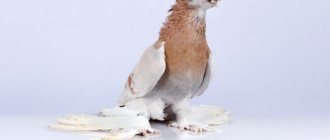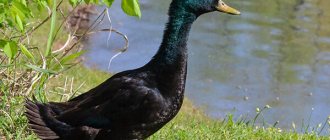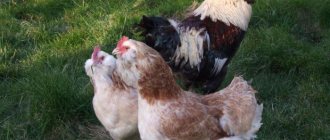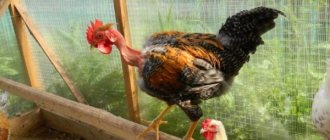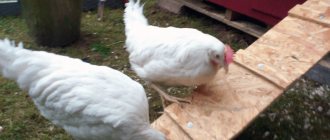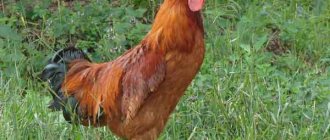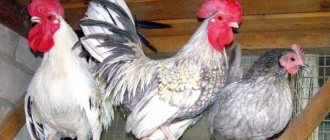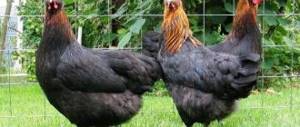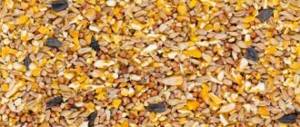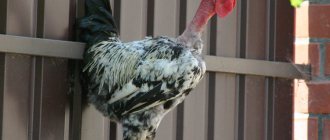Origin story
Before plunging into the history of the origin of Armavir pigeons, you need to learn about their “nomadic” way of life. The pigeon was domesticated many centuries ago. When relocating, people took not only all their scrub, but also living creatures with them, including pigeons.
Thus, in the 18th century, a hitherto unknown breed of pigeons came to Kuban, along with settlers from the cities of Tashkent, Samarkand and others. The birds had a fairly short beak and their legs were covered with a small amount of feathers.
Then a long selection process began. Breeders bred a breed with ideal characteristics for as long as 150 years, and, in the end, got pigeons with long feathers on their feet.
The breed was named after the city where it was, in fact, bred.
During the Great Patriotic War, the bird population declined catastrophically and was on the verge of extinction, but thanks to the experience and tireless work of specialists, the breed was preserved.
But even today the Armavir breed of pigeons cannot boast of large numbers; they are mainly bred by pigeon breeders in the North Caucasus region.
Origin
Before plunging into the history of the origin of Armavir pigeons, you need to learn about their “nomadic” way of life. The pigeon was domesticated many centuries ago. When relocating, people took not only all their scrub, but also living creatures with them, including pigeons. Thus, in the 18th century, a hitherto unknown breed of pigeons came to Kuban, along with settlers from the cities of Tashkent, Samarkand and others. The birds had a fairly short beak and their legs were covered with a small amount of feathers.
Then a long selection process began. Breeders bred a breed with ideal characteristics for as long as 150 years, and, in the end, got pigeons with long feathers on their feet.
The breed was named after the city where it was, in fact, bred.
During the Great Patriotic War, the bird population declined catastrophically and was on the verge of extinction, but thanks to the experience and tireless work of specialists, the breed was preserved. But even today the Armavir breed of pigeons cannot boast of large numbers; they are mainly bred by pigeon breeders in the North Caucasus region.
Appearance
Armavir pigeons are strong, harmoniously built birds with long legs and a proud posture.
According to the current standard, they must comply with the following description:
- The head is small, round, broad-browed, with slightly bulging, as if surprised, eyes. The color of the iris depends on the color of the plumage. White individuals have black eyes. The rest have a gray iris.
- The beak is white, wide, short, slightly curved. Located at an obtuse angle to the forehead line. Males have a beard under their beak. Upper beak and lower beak: - white, with a flesh-colored tint.
- The tongue is small, shaped like a spatula.
- Ceremony: - smooth, white, underdeveloped.
- The body is elongated, slightly directed forward, with a wide back, developed chest and a short, straight neck.
- The tail is straight with a dozen tail feathers.
- The wings are elongated, muscular, tightly pressed to the body.
- The limbs are long and feathered.
- The color can be red, gray, chocolate, black, yellow or white.
- Eyes: - black, eyelid: - white.
Exterior
Armavir white-headed pigeons are very beautiful birds. They are quite large and strong. The head is slightly oblong, with a flat crown, and can be either smooth or with a shell-shaped forelock. The eyes are medium size, black. The eyelids are white. The beak is quite long - 2-2.5 centimeters, and is white. The cere is poorly developed. The neck is not very long and has a slight bend. The chest is quite wide, slightly convex outward. The back is wide, especially in the shoulder area. The body is dense and stocky, slightly elongated. The wings are long (converging at the tail), tightly pressed to the body. The tail consists of 12 wide tail feathers. The ends of the tail feathers are semicircular. The legs of pigeons of this breed are distinguished by the presence of thick feathers. The feathers on the legs are straight and long. As mentioned above, there are four main colors of Armavir white-headed kosmachi: red yellow, gray and burnt. There is also one color - pure black pigeons, but they are very rare. The plumage should be rich in a certain color; along the edges the plumage has a darker color.
Varieties
White-headed Kosmach
The breed is represented by two species:
- the white-headed kosmach, distinguished by a unique pattern created by white and colored plumage;
- short-billed kosmach, which is usually one-colored.
Short-billed Kosmach
Representatives of these two species belong to fighting breeds.
Who are fighting pigeons? These are birds that, during flight, make specific clicks or pops with their wings, that is, “fight”.
Each variety has its own special features, but distinguishing them among the diverse “crowd” of purebred pigeons is not difficult. It’s not for nothing that the birds were called “kosmachi”.
The bird's legs are covered with long feathers - “shags”, which, with such characteristics as a proud gait, graceful posture and a special flight style, make it recognizable from thousands of bird representatives.
White-headed kosmach
In the Caucasus, he is called “bald”, regardless of whether his head is decorated with a forelock or not. The pigeon's head is elongated and flat at the crown. It can be decorated with a forelock, which resembles a shell, it goes from one ear to the other, and then goes into the mane.
All white-headed birds have black eyes and white (yellowish ones are also allowed) eyelids. The elegant, thin beak is pale pink and curved downwards. According to the standard, its length varies from 22 to 25 mm.
The cere is a skin thickening that is located at the base of the beak and is pinkish in color. The body is massive. The neck is short and slightly curved.
The wings are pressed tightly to the body. They are long, their edges reach the end of the tail. The tail feathers are semicircular in shape. The feet are covered with long and straight feathers and have spurs. The color can be yellow, red, coffee, black.
There are several disadvantages that are not allowed in this form:
- this is the diversity of pigeons;
- any eyelid color, except standard colors;
- the beak size cannot be larger or smaller than the standard;
- It is considered a defect if the hair is completely red;
- their size and the size of the spurs should not be less than 6 cm;
- the presence of three or more white feathers in the tail.
Short-billed kosmach
It differs from the previous species in the structure of the head - it is more rounded, and the forehead is wide and steep, and can be decorated with a forelock. The bird has wide eyelids (1-2 mm) of white or light yellow color. Eyes may be black or gray. It depends on the color of the plumage.
White individuals have black eyes, all other colors have gray eyes. The short, thick beak is curved downwards. A bird with a shorter beak is more valuable.
The smooth wax is white. The chest and back are wide - the first is slightly convex, the second tapers towards the tail. The wings are pressed tightly to the body. They reach the tail, which has up to 12 tail feathers. The paws are covered with feathers and resemble a skirt.
The plumage is dense. In color, it can be white, black, amber (light and dark), light chocolate, gray and dark chestnut. There are streaks on each feather, the coloring is darker towards the edges.
A fault is considered if the bird has:
- narrow or oblong head;
- her eyes are of different colors, or they are red or yellow, then she is rejected;
- It is not allowed in the breed to color the eyelids in any color other than white;
- or the shape of the beak in the form of a hairpin - thin, long;
- the length of the feathers on the paws cannot be less than 6 cm;
- individuals with feathers that stick out in all directions on their legs or with gaps are rejected;
- colored birds in cosmos cannot have more than four white feathers.
Breed characteristics
Pigeon breeders note the interesting exterior of Armavir short-billed birds. The birds are built disproportionately, but look like gentle creatures. They are characterized by the following features:
- small head, round in shape; wide forehead;
- eyes are normal size but appear large; the expression of the eyes is interesting; the birds seem to be surprised by something; the eyes have a slightly convex shape;
- individuals with white plumage have black eyes; birds that have different feather colors have gray eyes;
- the beak is wide but short; slightly bent; it forms an obtuse angle with the line of the forehead; length 12-14 mm; white beak; the pigeon's conformation score will be higher if its beak is shorter;
- the tongue is small, spatula-shaped;
- males have a beard under the beak;
- the neck is short; there are no bends;
- the chest and back are wide; the chest protrudes slightly forward;
- the body is long; slightly forward;
- the wings have a well-developed muscular system; the bird presses them tightly to the body; the wings are long; birds fold them up to the tail;
- there are 12 tail feathers in the tail; the shape of the tail is straight;
- unique limbs; they are long, covered with short feathers;
- the metatarsus have intensive plumage in the form of an inverted plate; the length of the feather can reach more than 6 cm; the plumage is slightly trimmed, giving it a certain shape; the plumage on the limbs forms a skirt; there are no gaps between the feathers;
- the plumage of pigeons depends on the line; it can be white, yellow, black, chocolate, gray, red.
The chicks are born with a long baby beak and a long tongue. After molting, the baby beak of the young animals disappears, and a beak appears like that of adults. It acquires the normal size inherent in the breed. The bird bites off its tongue, otherwise it would not fit in the oral cavity: the long tongue cannot be closed by the beak. That is why it has the shape of a blunt spatula. This is a distinctive feature of the Armavir short-billed pigeon breed. Individuals with a different tongue shape are discarded.
Conditions of detention
“Armavirs” belong to elite breeds, so they began to be kept in closed enclosures and cages. Such maintenance negatively affected their flying abilities, but it is precisely for the beauty of flight that these birds are valued.
It rises to a height of 50-100 meters, where it flies easily and calmly for 45-90 minutes. The pigeon can climb into a vertical column, the height of which is about 10 meters. During the flight the battle is dry and loud.
Birds make flips in the air from 2 to 9 times, depending on training.
In addition, the lack of freedom also negatively affects reproduction. And due to their small numbers, this is simply a disaster.
Therefore, if you decide to breed this unique breed, then you need to provide the birds with comfortable living conditions and give them the opportunity to make training flights.
Poultry house
If the birds are kept in a poultry house or other premises, then they are equipped with smooth perches. The walls are plastered and treated with whitewash. Lay bedding 6 cm or more thick on the floor.
For a pigeon to feel comfortable, it needs personal space. There should be 1.5 square meters per bird. m.
Pigeons are unpretentious in terms of care and maintenance, but to prevent the development of diseases, the poultry house is disinfected monthly.
Before carrying out this procedure, the room is cleaned of droppings, fluff, and dirt using a scraper. Then the room is washed with soapy water and treated with a blowtorch. This allows you to get rid of pathogens even in the most difficult to reach places.
In warm weather, complete disinfection is carried out - a set of measures aimed at thoroughly treating the room from various insects, microbes and viruses.
It includes:
- mechanical cleaning;
- wet cleaning;
- aerosol treatment.
During mechanical cleaning, armed with a scraper, they clean walls, floors, drinking bowls, feeders and perches. Next, all objects and premises are washed with hot water, adding caustic soda to it. After wet cleaning, the dovecote is ventilated and dried.
The last stage is treatment with formaldehyde vapor. To do this, for 1 cubic. meter take 45 g of formaldehyde, 30 g of potassium permanganate and 20 ml of water. All components are mixed in a ceramic container in the poultry house.
When mixed, a chemical reaction occurs, resulting in the formation of a gaseous substance.
Leaving the container inside the room, close all windows and doors tightly and leave for 2 hours. After treatment, the room is well ventilated. Vapors penetrate into all cracks and do not give any microbe a chance to survive.
To prevent the formation of mold and mildew, regularly ventilate the dovecote in warm and dry weather.
Feeding
Proper nutrition is the key to bird health. With an unbalanced diet, they experience digestive problems and vitamin deficiency.
Pigeons are fed 2 times a day - morning and evening. A serving of one individual is 40 g. In summer, 10 g is given in the morning, and the remaining 30 g in the evening. After the birds have eaten, the feeders are removed with any remaining food.
The summer menu consists of wheat, peas, oats and corn (10% each) and barley, lentils, millet (20% each).
During the molting period, the most nutritious and protein-rich grains - millet, oats, barley and peas - are left in the diet.
During the rutting period, the proportion of wheat in the menu is reduced to 5%, the amount of peas is increased to 35%, oats, corn, millet and lentils are taken at 10%, and barley at 20%.
The winter menu consists of barley and oats (40% each), corn and lentils (10% each).
Be sure to install a container with fine gravel in the room; the bird needs it for normal digestion of food.
Finely chopped fresh leaves of nettle, dandelion, spinach, and cabbage will provide the pigeons with vitamins. They are given every day in the summer.
The water in the drinking bowls should be at room temperature. When using tap water, it must first be left for 12 hours to allow the chlorine to evaporate.
Diseases and vaccinations
Vaccination is necessary for birds to increase their immunity to diseases and prevent epidemics from developing. It is carried out at the beginning of spring and autumn, that is, when there is a sharp change in weather and fluctuations in ambient temperature.
Vaccinations are done with a minimum interval of 10 days, that is, having injected one, the next one can be done only 10 days later.
They are often vaccinated against salmonellosis and Newcastle disease. If only the lazy have not heard about salmonellosis, then the second disease is little known to most of the population.
Beginning pigeon breeders should know that Newcastle disease or “whirling pigeon” is a viral disease spread by air. More than 2 thousand individuals die from it every year.
The virus kills the bird's nervous system and affects all internal organs. At the last stage, the bird constantly turns its head, its neck becomes bent and inflammation of the brain is diagnosed.
The disease spreads quite quickly among the livestock, and the wind spreads the virus over long distances. Prevention has proven itself in the fight against this disease, so it is better to play it safe and get vaccinated in a timely manner.
Features of reproduction
The dove is a faithful bird and chooses a mate for life. In this regard, it is necessary to keep the same number of females and males in the enclosure so that during the mating season everyone finds a mate.
Females cope well with the role of mother; they incubate and take care of the offspring on their own. Only the short-billed “Armavirians” will need help.
Due to its natural feature - a short beak, it cannot fully feed the chicks. Experts recommend laying eggs of this variety with other breeds of birds.
So, Armavir Kosmachi is a beautiful and unique breed that needs to fly regularly. Only in this case will she retain the skill of her amazing flight, which so fascinates a person and makes time stop.
Fighting beauties - Andijan, Armavir and Blagodarny pigeons
Many poultry farmers prefer pigeons to all other bird species. Why? In addition to their aesthetically attractive appearance and variety of breeds, pigeons are distinguished by many other advantages: unpretentiousness, the ability to survive in any conditions and beautiful flight. What beautiful pigeons these Armavir short-billed, Blagodarnensky, Andijan pigeons are... Let's talk about them in more detail.
Read also: Greenhouse Breadbox: features and rules for self-installation
Video "Beautiful Bird"
